Environmental Analysis of the Impact of Changing Shrink Film in the Mass Bottle Packaging Process
Abstract
:1. Introduction
2. Materials and Methods
3. Results and Discussion
3.1. Mechanical Properties of Films
3.2. Analysis of the Environmental Impact of Using Recycled Film for the Bulk Bottle Packaging Process
4. Discussions
5. Conclusions
- the tearing strength test results showed that RF film is less resistant to tearing in the transversal direction;
- the force required for destruction was greater for the NRF film;
- the free shrinkage of the tested film was higher for NRF film in the transversal direction;
- the strength tests showed lower yield stress and tensile strength values for RF film;
- the DSC analysis confirmed a lower melting point for the film with the addition of recyclates;
- the process using RF film was characterized by a smaller negative impact in all three tested damage categories;
- changing the film in the process to RF film reduced the impact in the resource damage category by almost 80%;
- changing the film reduced the harmfulness of the analyzed process by approximately 45% in the human health damage category;
- changing the film to one with the addition of recyclate in the mass packaging of bottles reduced the damage by approximately 50% in the ecosystems damage category.
Author Contributions
Funding
Institutional Review Board Statement
Informed Consent Statement
Data Availability Statement
Conflicts of Interest
References
- Shah, F.; Wu, W. Chapter Five—Use of plastic mulch in agriculture and strategies to mitigate the associated environmental concerns. Adv. Agron. 2020, 164, 231–287. [Google Scholar]
- Raport roczny Plastics Europe, 2022. Fundacja PlasticsEurope Polska, Warszawa. Available online: https://plasticseurope.org/pl/wp-content/uploads/sites/7/2022/09/Raport-Plastics-Europe-Polska-2022_PL.pdf (accessed on 15 June 2024).
- Ritima, B.; Ray, S. Sustainability and Life Cycle Assessment of Thermoplastic Polymers for Packaging: A Review on Fundamental Principles and Applications. Macromol. Mater. Eng. 2022, 307, 2100794. [Google Scholar]
- Branża Tworzyw Sztucznych 2023, Raport Fundacji PlasticsEurope Polska. Available online: https://plasticseurope.org/pl/wp-content/uploads/sites/7/2023/09/Raport-Roczny-PlasticsEurope_Polska-2023_.pdf (accessed on 20 June 2024).
- Horodytska, O.; Valdés, F.J.; Fullana, A. Plastic flexible films waste management–A state of art review. Waste Manag. 2018, 77, 413–425. [Google Scholar] [CrossRef] [PubMed]
- Burelo, M.; Hernández-Varela, J.; Medina, D.; Treviño-Quintanilla, C. Recent developments in bio-based polyethylene: Degradation studies, waste management and recycling. Heliyon 2023, 9, 11. [Google Scholar] [CrossRef] [PubMed]
- Cabrera, G.; Li, J.; Maazouz, A.; Lamnawar, K. A journey from processing to recycling of multilayer waste films: A review of main challenges and prospects. Polymers 2022, 14, 2319. [Google Scholar] [CrossRef] [PubMed]
- Steenis, N.D.; Van Herpen, E.; Van Der Lans, I.A.; Ligthart, T.N.; Van Trijp, H.C. Consumer response to packaging design: The role of packaging materials and graphics in sustainability perceptions and product evaluations. J. Clean. Prod. 2017, 162, 286–298. [Google Scholar] [CrossRef]
- Dehghani, S.; Hosseini, S.V.; Regenstein, J.M. Edible films and coatings in seafood preservation: A review. Food Chem. 2018, 240, 505–513. [Google Scholar] [CrossRef] [PubMed]
- Verghese, K.; Lewis, H.; Lockrey, S.; Williams, H. Packaging’s role in minimizing food loss and waste across the supply chain. Packag. Technol. Sci. 2015, 28, 603–620. [Google Scholar] [CrossRef]
- Korhonen, J.; Nuur, C.; Feldmann, A.; Birkie, S. Circular economy as an essentially contested concept. J. Clean. Prod. 2018, 175, 544–552. [Google Scholar] [CrossRef]
- Pawłowski, A.; Pawłowski, L. Wpływ sposobów pozyskiwania energii na realizację paradygmatów zrównoważonego rozwoju. Annu. Set Environ. Prot. Rocz. Ochr. Sr. 2016, 18, 19–37. [Google Scholar]
- Alaerts, L.; Augustinus, M.; Van Acker, K. Impact of Bio-Based Plastics on Current Recycling of Plastics. Sustainability 2018, 10, 1487. [Google Scholar] [CrossRef]
- Delva, L.; Deceur, C.; Van Damme, N.; Ragaert, K. Compatibilization of PET-PE blends for the recycling of multilayer packaging foils. AIP Conf. Proc. 2019, 2055, 1. [Google Scholar]
- Mumladze, T.; Tatariants, M.; Rimšaitė, A.; Yousef, S.; Denafas, G. Recycling of multilayer packaging foils by using different organic solvent. Iran. J. Energy Environ. 2019, 10, 38–42. [Google Scholar]
- Senthil Kumar, P.; Janet Joshiba, G. Properties of recycled polyester. In Recycled Polyester: Manufacturing, Properties, Test Methods and Identification; Springer: Berlin/Heidelberg, Germany, 2020; pp. 1–14. [Google Scholar]
- Signorini, C.; Volpini, V. Mechanical Performance of Fiber Reinforced Cement Composites Including Fully-Recycled Plastic Fibers. Fibers 2021, 9, 16. [Google Scholar] [CrossRef]
- Czarnecka-Komorowska, D.; Wiszumirska, K.; Garbacz, T. Films LDPE/LLDPE made from post–consumer plastics: Processing, structure, mechanical properties. Advances in Science and Technology. Res. J. 2018, 12, 134–142. [Google Scholar]
- Cascone, S.; Ingrao, C.; Valenti, F.; Porto, S.M. Energy and environmental assessment of plastic granule production from recycled greenhouse covering films in a circular economy perspective. J. Environ. Manag. 2020, 254, 109796. [Google Scholar] [CrossRef]
- Costamagna, M.; Massaccesi, B.M.; Mazzucco, D.; Baricco, M.; Rizzi, P. Environmental assessment of the recycling process for polyamides-Polyethylene multilayer packaging films. Sustain. Mater. Technol. 2023, 35, e00562. [Google Scholar] [CrossRef]
- Bataineh, K.M. Life-cycle assessment of recycling postconsumer high-density polyethylene and polyethylene terephthalate. Adv. Civ. Eng. 2020, 2020, 8905431. [Google Scholar] [CrossRef]
- Camargo, R.V.; Saron, C. Mechanical–chemical recycling of low-density polyethylene waste with polypropylene. J. Polym. Environ. 2020, 28, 794–802. [Google Scholar] [CrossRef]
- Walichnowska, P.; Idzikowski, A. Assessment and analysis of the environmental impact of the thermo-shrinkable packaging process on the way the packaging machine is powered based on LCA. Manag. Syst. Prod. Eng. 2023, 31, 355–360. [Google Scholar] [CrossRef]
- Ballestar de las Heras, R.; Colom, X.; Cañavate, J. Comparative Analysis of the Effects of Incorporating Post-Industrial Recycled LLDPE and Post-Consumer PE in Films: Macrostructural and Microstructural Perspectives in the Packaging Industry. Polymers 2024, 16, 916. [Google Scholar] [CrossRef] [PubMed]
- López de Dicastillo, C.; Velásquez, E.; Rojas, A.; Guarda, A.; Galotto, M.J. The use of nanoadditives within recycled polymers for food packaging: Properties, recyclability, and safety. Compr. Rev. Food Sci. Food Saf. 2020, 19, 1760–1776. [Google Scholar] [CrossRef] [PubMed]
- Markovičová, L.; Zatkalíková, V.; Kojnoková, T.; Gaňa, D.; Liptáková, T. The physical–mechanical propertiesof low-density polyethylene films. Conf. Ser. Mater. Sci. Eng. 2020, 726, 1. [Google Scholar]
- Mooninta, S.; Poompradub, S.; Prasassarakich, P. Packaging film of PP/LDPE/PLA/clay composite: Physical, barrier and degradable properties. J. Polym. Environ. 2020, 28, 3116–3128. [Google Scholar] [CrossRef]
- PN-EN ISO 527-1:2020-01; Plastics—Determination of Tensile Properties—Part 1: General Principles. The Polish Committee for Standardization: Warsaw, Poland, 2020.
- PN-EN ISO 527-3:2019-01; Plastics—Determination of Tensile Properties—Part 3: Test Conditions for Films and Plates. The Polish Committee for Standardization: Warsaw, Poland, 2019.
- PN-EN ISO 6383-2:2005; Plastics—Film and Sheeting—Determination of Tear Resistance—Part 2: Elmendorf Method. The Polish Committee for Standardization: Warsaw, Poland, 2005.
- PN-EN14477:2005; Packaging—Flexible Packaging Material—Determination of Puncture Resistance—Test Methods. The Polish Committee for Standardization: Warsaw, Poland, 2005.
- Jackson, R.B.; Le Quere, C.; Andrew, R.M.; Canadell, J.G.; Peters, G.P.; Roy, J.; Wu, L. Warning signs for stabilizing global CO2 emissions. Environ. Res. Lett. 2017, 12, 110202. [Google Scholar] [CrossRef]
- Kloziński, A.; Jakubowska, P. Właściwości mechaniczne folii poużytkowych stosowanych w rolnictwie. Inż. Ap. Chem. 2012, 51, 231–232. [Google Scholar]
- ASTM D 2732; Standard Test Method for Unrestrained Linear Thermal Shrinkage of Plastic Film and Sheeting. American Society for Testing and Materials–ASTM: West Conshohocken, PA, USA, 2012.
- Available online: https://www.mt.com/pl/pl/home/products/Laboratory_Analytics_Browse/TA_Family_Browse/ta-instruments/thermal-analysis-system-TGA-2.html (accessed on 20 June 2024).
- ISO 11357-3:2018; Plastics—Differential Scanning Calorimetry (DSC)—Part 3: Determination of Temperature and Enthalpy of Melting and Crystallization. International Organization for Standardization: Geneva, Switzerland, 2018.
- PN-EN ISO 14044:2009; Environmental Management—Life Cycle Assessment—Requirements and Guidelines. The Polish Committee for Standardization: Warsaw, Poland, 2009.
- PN-EN ISO 14040:2009; Environmental Management—Life Cycle Assessment—Principles and Framework. The Polish Committee for Standardization: Warsaw, Poland, 2009.
- SimaPro database manual Methods library, 2020 PRé Sustainability. Available online: https://simapro.com/wp-content/uploads/2022/07/DatabaseManualMethods.pdf (accessed on 10 June 2024).
- Baldowska-Witos, P.; Kruszelnicka, W.; Kasner, R.; Rudnicki, J.; Tomporowski, A.; Flizikowski, J. Impact of the plastic bottle production on the natural environment. Part 1. Application of the ReCiPe 2016 assessment method to identify environmental problems. Przem. Chem. 2019, 98, 1662–1667. [Google Scholar]
- Idzikowski, A.; Walichnowska, P. The Management of the Technological Process of a Product on the Example a Shrink Film in the Aspect Life Cycle Assessment. Syst. Saf. Hum. Tech. Facil. Environ. 2022, 4, 1–9. [Google Scholar] [CrossRef]
- Bertoldi, P.; Mosconi, R. Do energy efficiency policies save energy? A new approach based on energy policy indicators (in the EU Member States). Energy Policy 2020, 139, 111320. [Google Scholar] [CrossRef]
- Awasthi, K.; Awasthi, S. Green Computing: A Sustainable and Eco-Friendly Approach for Conservation of Energy (A Contribution to Save Environment). In Sustainable Computing: Transforming Industry 4.0 to Society 5.0; Springer: Berlin/Heidelberg, Germany, 2023; pp. 319–333. [Google Scholar]
- Silva, R.R.A.; Marques, C.S.; Arruda, T.R.; Teixeira, S.C.; de Oliveira, T.V. Biodegradation of polymers: Stages, measurement, standards and prospects. Macromol 2023, 3, 371–399. [Google Scholar] [CrossRef]
- Chen, L.; Matloob, S.; Sunlei, Y.; Qalati, S.A.; Raza, A.; Limón, M.L.S. A moderated–mediated model for eco-conscious consumer behavior. Sustainability 2023, 15, 897. [Google Scholar] [CrossRef]
- Alagarsamy, S.; Mehrolia, S.; Mathew, S. How green consumption value affects green consumer behaviour: The mediating role of consumer attitudes towards sustainable food logistics practices. Vision 2021, 25, 65–76. [Google Scholar] [CrossRef]
- Kloziński, A.; Jakubowska, P. Folie wytwarzane z dodatkiem recyklatów. Inżynieria I Apar. Chem. 2020, 5, 61–62. [Google Scholar]
- Kelar, K.; Mencel, K. Badanie wybranych właściwości odpadowej folii polietylenowej. Przetwórstwo Tworzyw 2012, 6, 150. [Google Scholar]
- Aldas, M.; Paladines, A.; Valle, V.; Pazmiño, M.; Quiroz, F. Effect of the prodegradant-additive plastics incorporated on the polyethylene recycling. Int. J. Polym. Sci. 2018, 1, 2474176. [Google Scholar] [CrossRef]
- Siracusa, V.; Dalla Rosa, M.; Romani, S.; Rocculi, P.; Tylewicz, U. Life Cycle Assessment of multilayer polymer film used on food packaging field. Procedia Food Sci. 2011, 1, 235–239. [Google Scholar] [CrossRef]
- Toniolo, S.; Mazzi, A.; Niero, M.; Zuliani, F.; Scipioni, A. Comparative LCA to evaluate how much recycling is environmentally favourable for food packaging. Resour. Conserv. Recycl. 2013, 77, 61–68. [Google Scholar] [CrossRef]
- Foschi, E.; Zanni, S.; Bonoli, A. Combining eco-design and LCA as decision-making process to prevent plastics in packaging application. Sustainability 2020, 12, 9738. [Google Scholar] [CrossRef]
- Hauschild, M.Z. Introduction to LCA methodology. In Life Cycle Assessment: Theory and Practice; Springer: Berlin/Heidelberg, Germany, 2018; pp. 59–66. [Google Scholar]
- De Benedetto, L.; Klemeš, J. The Environmental Performance Strategy Map: An integrated LCA approach to support the strategic decision-making process. J. Clean. Prod. 2009, 17, 900–906. [Google Scholar] [CrossRef]
- Moore, C.J. Synthetic polymers in the marine environment: A rapidly increasing, long-term threat. Environ. Res. 2008, 108, 131–139. [Google Scholar] [CrossRef]
- Gola, D.; Tyagi, P.K.; Arya, A.; Chauhan, N.; Agarwal, M.; Singh, S.K.; Gola, S. The impact of microplastics on marine environment: A review. Environ. Nanotechnol. Monit. Manag. 2021, 16, 100552. [Google Scholar] [CrossRef]
- Dong, H.; Yang, G.; Zhang, Y.; Yang, Y.; Wang, D.; Zhou, C. Recycling, disposal, or biodegradable-alternative of polyethylene plastic film for agricultural mulching? A life cycle analysis of their environmental impacts. J. Clean. Prod. 2022, 380, 134950. [Google Scholar] [CrossRef]


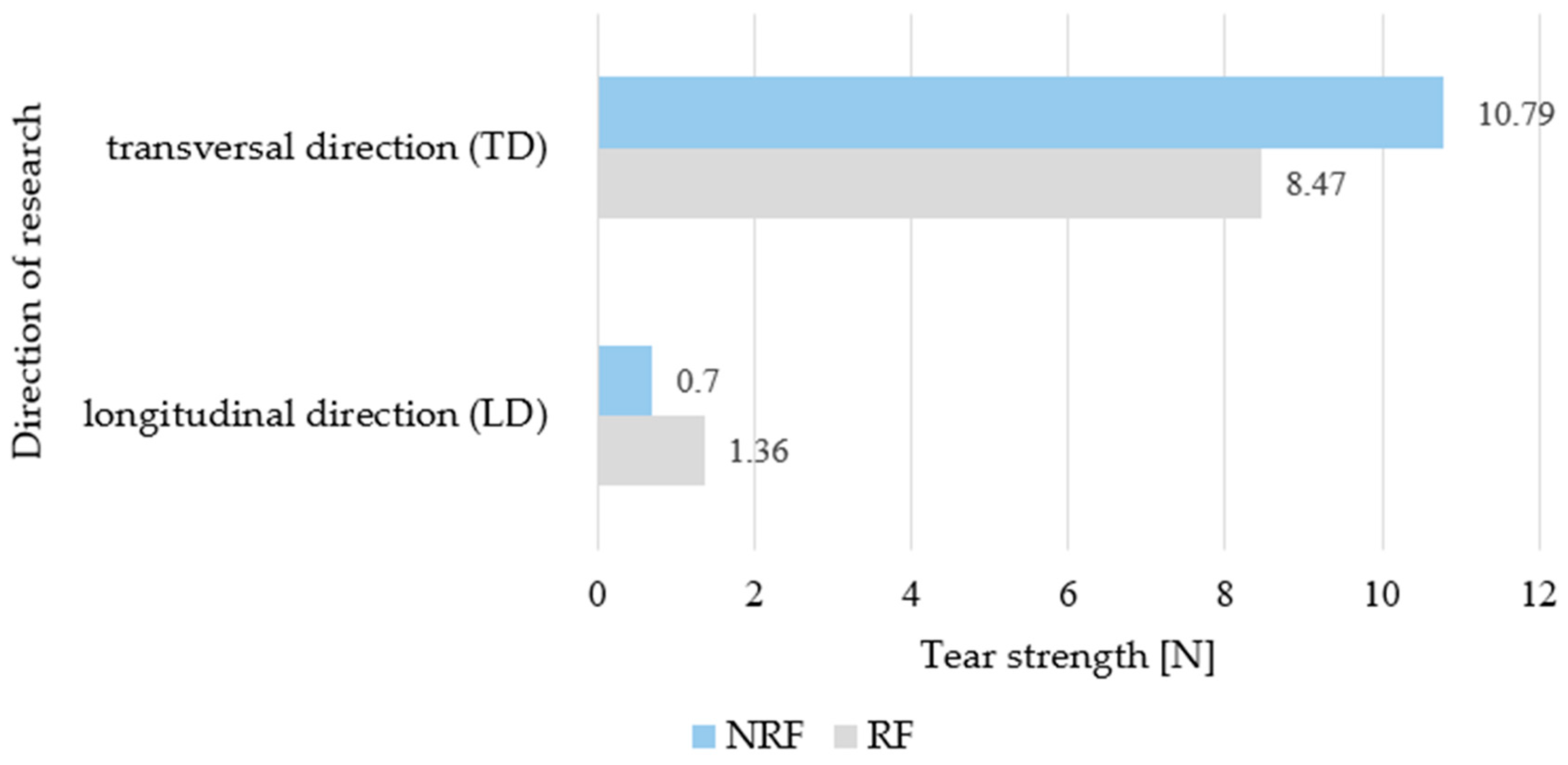
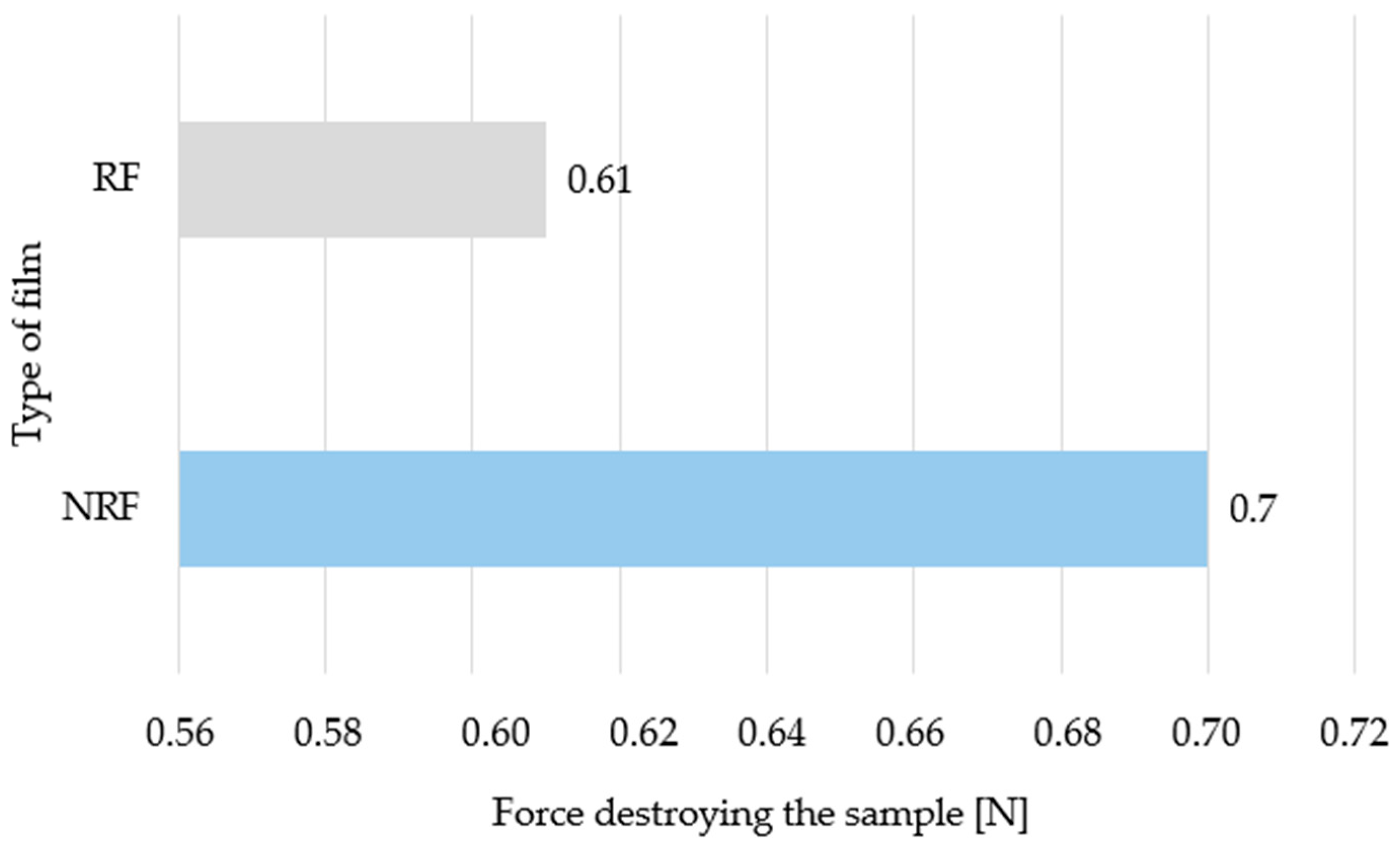

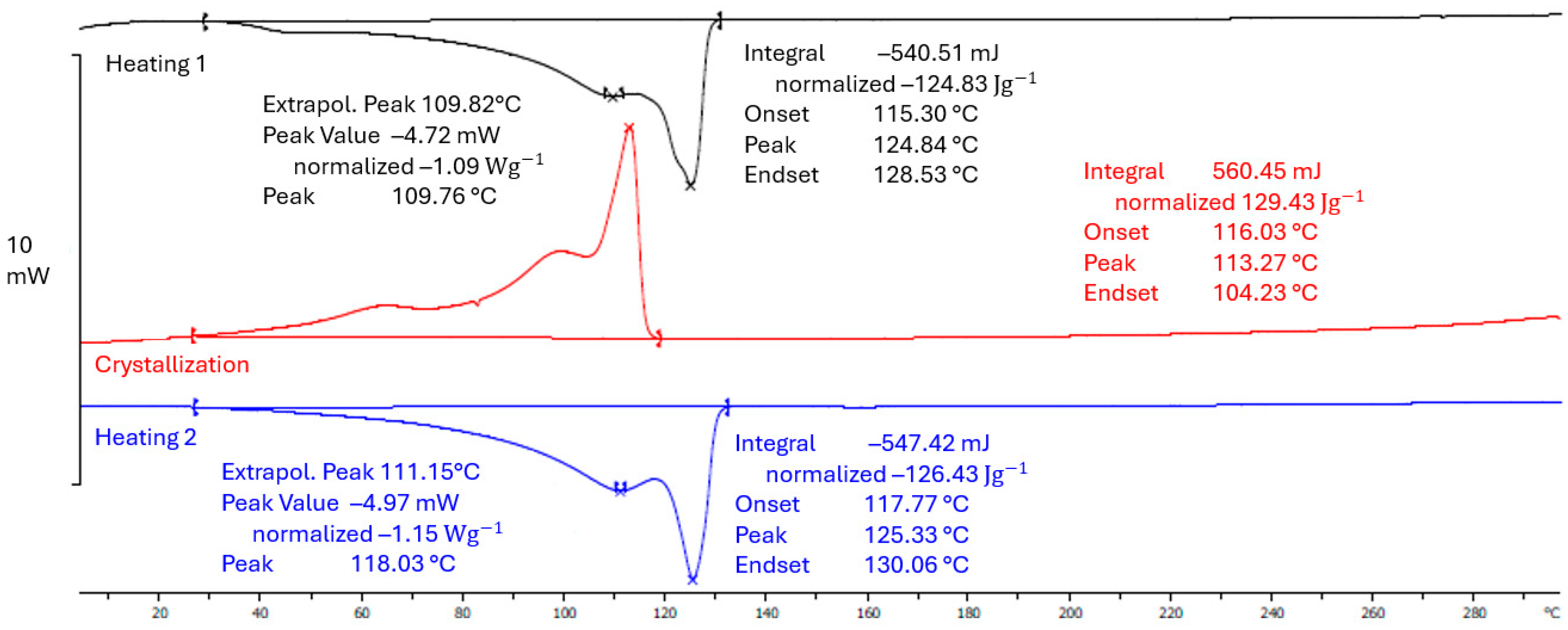
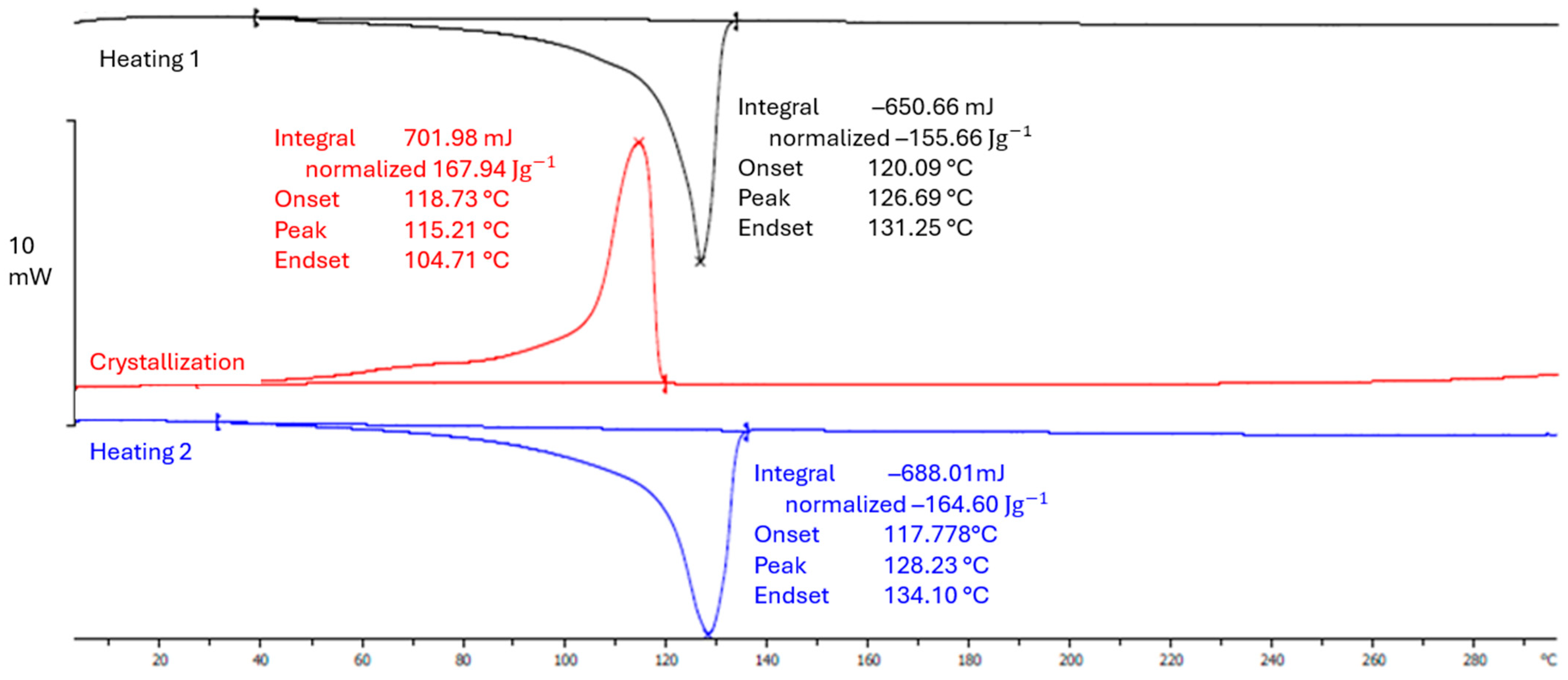

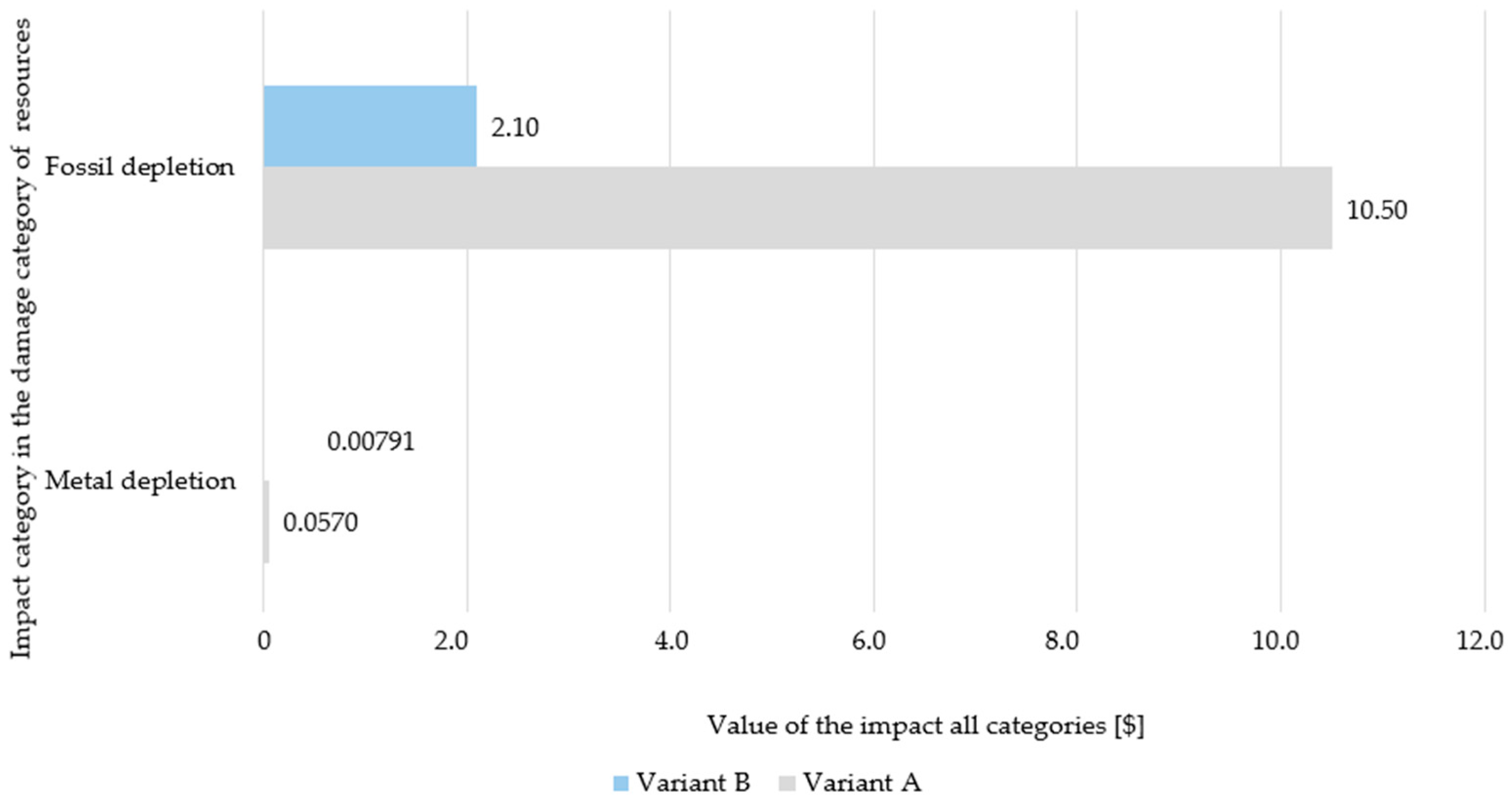
| Film Properties | NRF Film | RF Film | |||
|---|---|---|---|---|---|
| LD | TD | LD | TD | ||
| Tensile strength [MPa] SD | 1 | 38.63 | 35.53 | 21.00 (−45.42%) | 21.73 (−38.90%) |
| 2 | 2.78 | 2.38 | 1.57 (−43.51%) | 1.33 (−44.14%) | |
| Stress at break [MPa] SD | 1 | 37.62 | 35.10 | 18.48 (−50.91%) | 21.50 (−48.91%) |
| 2 | 3.78 | 3.23 | 1.96 (−48.14%) | 1.45 (−55.12%) | |
| Yield strength [MPa] SD | 1 | - | 22.70 | - | 11.96 (−47.36%) |
| 2 | - | 0.64 | - | 0.32 (−50.01%) | |
| Elongation at maximum tensile stress [%] SD | 1 | 654.83 | 952.61 | 416.62 (−36.47%) | 709.01 (−25.63%) |
| 2 | 43.12 | 28.71 | 34.43 (−20.21%) | 40.87 (+42.12%) | |
| Elongation at break [%] SD | 1 | 655.15 | 953.32 | 418.31 (−36.24%) | 711.35 (−25.42%) |
| 2 | 43.02 | 27.95 | 33.02 (−23.31%) | 29.82 (+6.81%) | |
| Elongation at yield point [%] SD | 1 | 9.57 | 7.82 | 11.53 (+21.13%) | 11.33 (+44.83%) |
| 2 | 0.26 | 0.51 | 2.26 | 0.78 (+41.81%) | |
| Parameter | RF Film | NRF Film |
|---|---|---|
| Melting Temperature, °C | Heating 1 | |
| 109.76 (peak 1) 124.69 (peak 2) | 126.69 | |
| Heating 2 | ||
| 118.03 (peak 1) 125.33 (peak 2) | 128.23 | |
| Crystallization temperature, °C | Crystallization | |
| 113.27 | 115.21 | |
| Parameter | Variant A | Variant B |
|---|---|---|
| Electrical energy, kWh | 46.10 | 46.10 |
| Energy consumption [kWh] | ||
| Supplying products | 5.07 | 5.07 |
| Product formatting | 4.52 | 4.52 |
| Wrapping a group of products with film | 1.48 | 1.48 |
| Shrinking the film | 34.58 | 34.58 |
| Cooling packs | 0.46 | 0.46 |
| Consumption of the material [kg] | ||
| NFR film | 31.52 | 0 |
| RF film | 0 | 31.52 |
| Damage Category | Unit | Variant A | Variant B |
|---|---|---|---|
| Human Health | DALY | 0.000225 | 0.0001216 |
| Ecosystems | Species.yr | 0.0000009110 | 0.0000004454 |
| Resources | USD | 10.56 | 2.11 |
| Impact Category | Unit | Variant A | Variant B |
|---|---|---|---|
| Climate change Human Health | DALY | 1.54 × 10−4 | 7.33 × 10−5 |
| Ozone depletion | DALY | 5.48 × 10−9 | 2.51 × 10−9 |
| Human toxicity | DALY | 3.05 × 10−5 | 2.68 × 10−5 |
| Photochemical oxidant formation | DALY | 1.32 × 10−8 | 4.91 × 10−9 |
| Particulate matter formation | DALY | 3.95 × 10−5 | 2.09 × 10−5 |
| Ionizing radiation | DALY | 5.03 × 10−8 | 2.58 × 10−8 |
| Impact Category | Unit | Variant A | Variant B |
|---|---|---|---|
| Climate change Ecosystems | species.yr | 8.74 × 10−7 | 4.15 × 10−7 |
| Terrestrial acidification | species.yr | 2.60 × 10−9 | 1.52 × 10−9 |
| Freshwater eutrophication | species.yr | 2.97 × 10−9 | 2.56 × 10−9 |
| Terrestrial ecotoxicity | species.yr | 5.72 × 10−10 | 4.57 × 10−10 |
| Freshwater ecotoxicity | species.yr | 9.53 × 10−10 | 9.30 × 10−10 |
| Marine ecotoxicity | species.yr | 1.86 × 10−10 | 1.82 × 10−10 |
| Agricultural land occupation | species.yr | 1.99 × 10−8 | 1.69 × 10−8 |
| Urban land occupation | species.yr | 7.04 × 10−9 | 4.36 × 10−9 |
| Natural land transformation | species.yr | 3.10 × 10−9 | 1.25 × 10−9 |
Disclaimer/Publisher’s Note: The statements, opinions and data contained in all publications are solely those of the individual author(s) and contributor(s) and not of MDPI and/or the editor(s). MDPI and/or the editor(s) disclaim responsibility for any injury to people or property resulting from any ideas, methods, instructions or products referred to in the content. |
© 2024 by the authors. Licensee MDPI, Basel, Switzerland. This article is an open access article distributed under the terms and conditions of the Creative Commons Attribution (CC BY) license (https://creativecommons.org/licenses/by/4.0/).
Share and Cite
Walichnowska, P.; Mazurkiewicz, A.; Martínez Valle, J.M.; Polishchuk, O. Environmental Analysis of the Impact of Changing Shrink Film in the Mass Bottle Packaging Process. Appl. Sci. 2024, 14, 6641. https://doi.org/10.3390/app14156641
Walichnowska P, Mazurkiewicz A, Martínez Valle JM, Polishchuk O. Environmental Analysis of the Impact of Changing Shrink Film in the Mass Bottle Packaging Process. Applied Sciences. 2024; 14(15):6641. https://doi.org/10.3390/app14156641
Chicago/Turabian StyleWalichnowska, Patrycja, Adam Mazurkiewicz, José Miguel Martínez Valle, and Oleh Polishchuk. 2024. "Environmental Analysis of the Impact of Changing Shrink Film in the Mass Bottle Packaging Process" Applied Sciences 14, no. 15: 6641. https://doi.org/10.3390/app14156641






